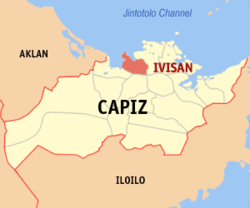Ivisan | |
|---|---|
| Municipality of Ivisan | |
 A house in Ivisan | |
 Map of Capiz with Ivisan highlighted | |
 Interactive map of Ivisan | |
Location within the Philippines | |
| Coordinates: 11°31′18″N122°41′27″E / 11.52167°N 122.69083°E | |
| Country | Philippines |
| Region | Western Visayas |
| Province | Capiz |
| District | 2nd district |
| Barangays | 15 (see Barangays) |
| Government | |
| • Type | Sangguniang Bayan |
| • Mayor | Felipe Neri N. Yap (1Capiz) |
| • Vice Mayor | Jose Romeo U. Yap (1Capiz) |
| • Representative | Jane T. Castro (Lakas) |
| • Municipal Council | Members |
| • Electorate | 21,770 voters (2025) |
| Area | |
• Total | 54.2 km2 (20.9 sq mi) |
| Elevation | 15 m (49 ft) |
| Highest elevation | 390 m (1,280 ft) |
| Lowest elevation | −1 m (−3.3 ft) |
| Population (2024 census) [3] | |
• Total | 32,853 |
| • Density | 606/km2 (1,570/sq mi) |
| • Households | 7,794 |
| Economy | |
| • Income class | 4th municipal income class |
| • Poverty incidence | 15.83 |
| • Revenue | ₱ 170.8 million (2022) |
| • Assets | ₱ 352.2 million (2022) |
| • Expenditure | ₱ 112.8 million (2022) |
| • Liabilities | ₱ 83.36 million (2022) |
| Service provider | |
| • Electricity | Capiz Electric Cooperative (CAPELCO) |
| Time zone | UTC+8 (PST) |
| ZIP code | 5805 |
| PSGC | |
| IDD : area code | +63 (0)36 |
| Native languages | Capisnon Hiligaynon Tagalog |
| Website | lguivisan |
Ivisan, officially the Municipality of Ivisan (Capiznon/Hiligaynon: Banwa sang Ivisan; Tagalog : Bayan ng Ivisan), is a municipality in the province of Capiz, Philippines. According to the 2024 census, it has a population of 32,853 people. [5]

